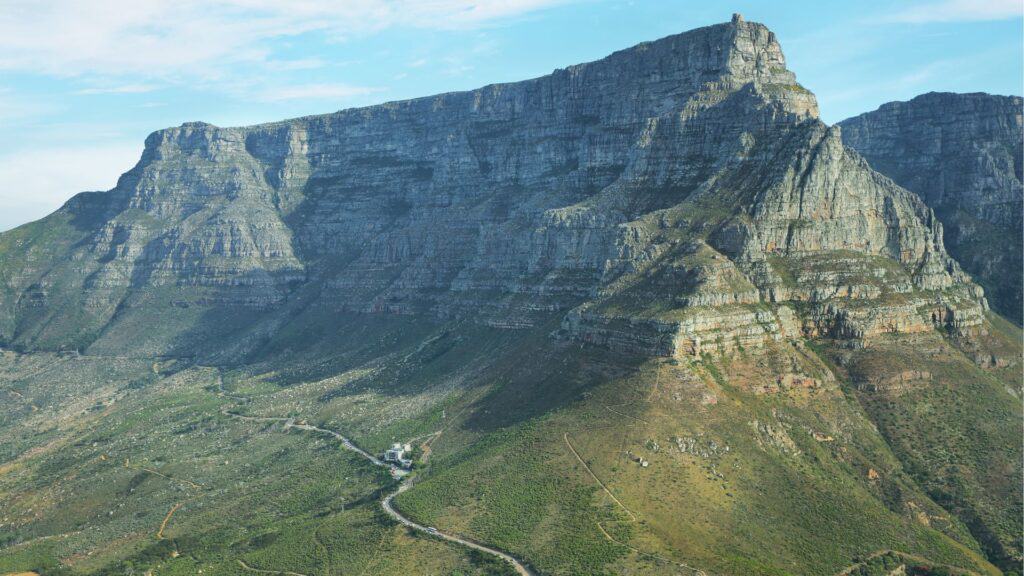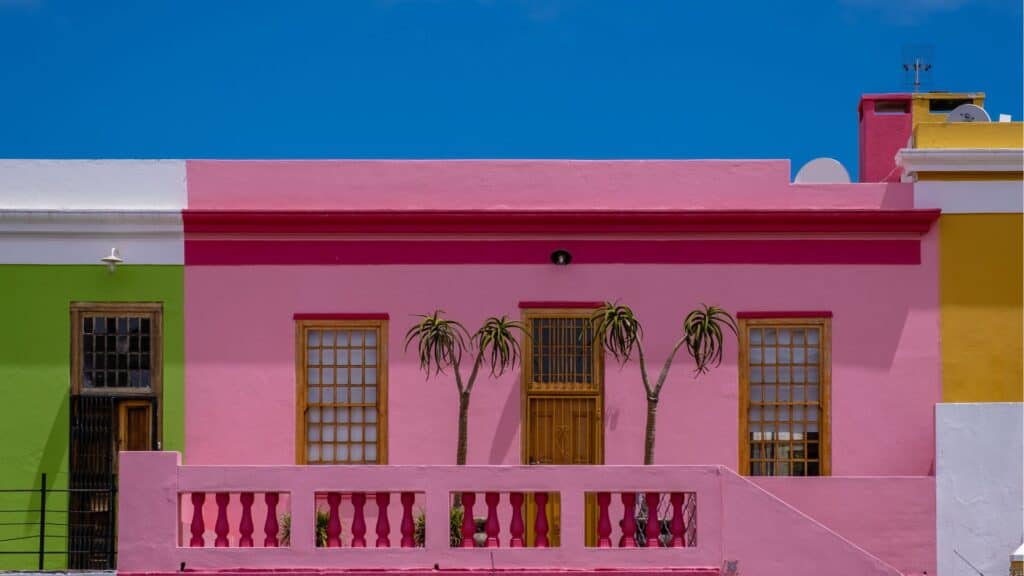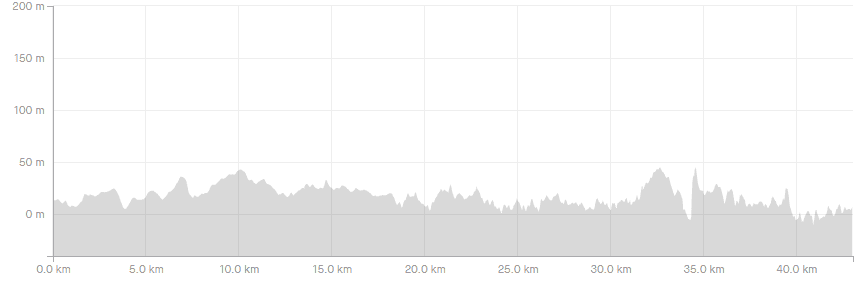Are you a marathoner looking for your next challenge? Why not consider running the Cape Town Marathon?
The race takes place in one of the most beautiful cities in the world, and the route showcases some of Cape Town’s most iconic landmarks.
As Africa’s 1st Major Candidate Race, this scenic route offers you breathtaking views of Table Mountain—one of the New 7 Wonders of Nature—the Atlantic Ocean, historic landmarks, as well as many famous attractions and the hustle and bustle of Woodstock.
In this blog post, we’ll take a closer look at the Cape Town Marathon Route, giving you a detailed profile, map, and run-through of what to expect on the day.
So, let’s dive in…

A Brief Overview of the History of the Cape Town Marathon
The first-ever Sanlam Cape Town Marathon took place back in September 2007 with a small but highly competitive group of runners.
Over the years, it has steadily grown into a prominent city marathon that attracts a diverse range of participants.
From elite athletes to wheelchair racers, and even those taking on a marathon for the first time or running for fun, this event brings together runners from all walks of life.
The Cape Town Marathon has achieved elite status in the world of marathons by receiving candidacy for the Abbott World Marathon Majors.
In 2018, Cape Town was also recognized as the event capital of the world, thanks to its stunning natural beauty, abundant wildlife, including the iconic Table Mountain, rich cultural diversity, and historic landmarks.
Not to forget the warm and welcoming people of Cape Town, known as Capetonians, who make this event even more special.
This marathon holds the prestigious IAAF GOLD label and is one of the select few marathons worldwide that prioritizes sustainability.
It’s a climate-neutral event with a commitment to zero waste going to landfills. While running through the picturesque streets of Cape Town, you not only get to enjoy the city’s breathtaking scenery but also explore its rich history.
Taking place in October, during mid-spring, the Cape Town Marathon benefits from favourable weather conditions. As the city awakens from a cold, wet winter, the route through Cape Town City comes alive with the vibrancy of renewed energy.

Cape Town Marathon Elevation Chart

Cape Town Marathon Course Map
The Run-Through Of The Cape Town Marathon Route
The Sanlam Cape Town Marathon, covering a distance of 42.2 kilometres (26.2 miles), starts just outside the DHL Stadium in Green Point, on Fritz Sonnenburg Road.
This marathon kicks off on level ground, giving you a smooth start to the course. The first kilometre (0.6 miles) is fairly flat, with only a slight incline. It’s an ideal opportunity to find your pace and get into your running groove for the journey ahead.
From the starting point on Fritz Sonnenburg Road, you’ll run about 500 meters (0.3 miles) until you reach a T-junction at Beach Road.
Here, make a right turn and continue along Beach Road for the next kilometre (0.6 miles) until you reach a roundabout, also known as a traffic circle in some places. You’re now in the renowned V&A Waterfront area.
At this point, take a right turn onto Granger Bay Boulevard.
Stay on Granger Bay Boulevard until you reach the third roundabout or traffic circle, which is near a McDonald’s restaurant. As you continue, you’ll pass the DHL Stadium on your right.
At this juncture, make a left turn onto the M6, heading towards the city centre.
Around the second kilometre (1.2 miles), you’ll encounter a gentle uphill section. The elevation gain is moderate, allowing you to conserve your energy.
Stay on the M6 for the next 1.5 kilometres (0.9 miles), which takes you on a descent. This descent offers a refreshing break from the previous climb, and you’ll even feel the cool ocean breeze not far from you.
The descent is moderately steep, so focus on maintaining control and balance.
Once you reach the Foreshore Freeway bridge, make a left turn onto the M62.
The fourth kilometre (1.2 miles) involves a slight descent with minimal elevation changes. It’s a chance for you to recover and gear up for what lies ahead.
The route stays relatively flat as you approach the 5 km (3.1 mile) mark.
Here, you’ll pass the Cape Town International Centre (CTICC) on your right, where the 2023 Women’s World Cup Netball took place, and further down, you’ll spot the Netcare Christiaan Barnard Memorial Hospital.
The fifth kilometre (3.1 miles) presents a gentle climb with a slight elevation gain. It’s not overly challenging, but enough to keep you engaged. The route leads you to Woodstock, one of Cape Town’s oldest suburbs, as you exit the city centre.
After passing the 6-kilometer (3.7-mile) mark, you’ll face a sharp uphill climb that will certainly test your mettle. Be sure to relax and take it easy here so as to not over-exert yourself too early in the race.
As you reach the seventh kilometre (4.3 miles), you’ll enjoy a gradual descent, a welcome relief as the route takes you deeper into Woodstock. Take advantage of this downhill stretch to recover for the next leg of the marathon.
Moving into the eighth kilometre (5 miles), be prepared for another climb. It’s noticeable but manageable, so keep your pace easy, walk if you need to, and stay motivated as you ascend.
In the 9th to 10th kilometres (5.6 to 6.2 miles) around Observatory, the course maintains a similar elevation with minor ups and downs, reminding you that the marathon has its share of challenges.
At the 11th kilometre (6.8 miles), a steeper descent awaits, allowing you to gain speed. Be cautious, though, as the decline can be tough on your legs.
Take in the beautiful views as you navigate this downhill portion.
The 12th and 13th kilometres (7.5 and 8.1 miles) continue with a gentle descent, giving you a chance to recover from the previous downhill. This section offers a brief respite before the terrain changes again.
As you enter the 14th kilometre (8.7 miles) in Claremont, brace yourself for another uphill climb. It’s a noticeable elevation gain, but the scenic rewards from higher ground are worth it. Keep your determination high and keep pushing forward.
In the 16th kilometre (9.9 miles), expect rolling terrain with intermittent ups and downs. The elevation changes are minor, requiring a balanced effort.
Hitting the 23rd kilometre (14.3 miles), the course presents a challenging descent with a steep drop in elevation. This section demands careful footing and control as you navigate the downhill terrain. Maintain a controlled pace to avoid overexertion.
After reaching the 26-kilometer (16.2-mile) mark in Salt River, the course offers nearly level ground with only minor elevation changes. It’s a section that lets you maintain your pace consistently.
As you approach the 30-kilometer (18.6-mile) mark in District Six, prepare for a steeper ascent. The elevation gain is significant, so focus on maintaining a steady pace.
This part of the course is challenging not necessarily due to the length and gradient of the hill but rather because of where it is in the marathon distance. You are already on tired legs and then need to navigate your way up another hill. Don’t fret, take it as you can, again – walk where you need to walk, and know that after this hill you are heading back towards the finish line and there are no more hills to get through.
Around the 33-kilometer (20.5-mile) mark, you’ll reach the highest point of the course, situated at an altitude of 53 meters (174 feet). Afterwards, get ready for a steep descent with a significant drop in elevation.
This part of the course can be quite challenging, so exercise caution and control as you navigate the downhill terrain. It’s also an opportunity to harness gravity to your advantage and gain some speed.
You’re now heading toward the city centre from District Six. Exercise caution and control on this demanding downhill stretch, using gravity to your advantage.
Continuing on, you’ll experience a gradual descent with a moderate elevation drop, allowing you to recover from the previous challenges and prepare for the final stages of the marathon.
When you reach approximately 35 kilometres (21.7 miles) into the marathon, keep an eye out for the McDonald’s restaurant along Granger Bay Boulevard. This spot is worth remembering because when you encounter it for the third time, you’ll be approaching the final meters of the race.
This is where you need to dig deep into some mental strength, while you see the finish line you still have 7kms to tackle and this can sometimes knock runners off their momentum.
Passing through Green Point, you’ll head to Sea Point, covering approximately 2-3 kilometres (1.2 – 1.9 miles) before making a U-turn back to Green Point.
The 42nd kilometre (26 miles) on Helen Suzman Boulevard in Green Point marks the last leg of the Cape Town Marathon. It features a slight descent, allowing you to give it your all in the closing meters of the race.
As you exit Helen Suzman Boulevard, make a left turn into Green Point Park through the east gate. Finish with determination and relish the feeling of accomplishment as you cross the finish line on Vlei Road, just across from DHL Stadium where your incredible marathon journey began.
Now that you have an idea of what awaits you in Cape Town, here’s more of what you should expect along the Cape Town Marathon Route.

Grab your Cape Town Marathon Training Plan here!
What You Can Expect At The Start Of The Cape Town Marathon
The Start Chutes:
For those who have participated in the Cape Town Marathon in the past, please note that there has been a change in the start line location. The start line is now at Fritz Sonnenberg, and you will enter the start area from the DHL Stadium Forecourt in Green Point.
Make sure to arrive at least 45 minutes to an hour before your batch start time. Not all groups start simultaneously, with the Elite Wheelchair Division starting at 06h10 and the last group at around 07h10.
You’ll be pre-loaded into your correct batch in the Start Chute area.
It’s worth noting that you should plan ahead for potential traffic challenges, especially if not staying in areas like Greenpoint or Seapoint. The marathon’s popularity may bring about increased congestion, so early travel arrangements or accommodations in proximity to the route are advisable for a smoother experience
The Batch Starts:
The letter in the coloured triangle at the bottom of your race number indicates your start batch. Your race pack envelope will clearly specify when your batch closes and starts.
Allow 45 minutes to an hour to arrive, drop off your tog bag, and get into your batch. Be sure to enter your batch before it closes.
Will There Be Toilets Along The Cape Town Marathon Route?
Toilets will be available next to the Start Chutes, at the Hydration Stations (located every 3km/1.9 miles), and on the Finishers Field.
Where Can I Leave My Bag?
The Tog Bag facility will be available to drop your bag at the start, and you can collect it after the race in the finished village. Ensure your bag is labelled, and you will receive a matching armband.
About The Virgin Active Warm-Up
Virgin Active, the official exercise partner, invites all runners to warm up in their designated zone and participate in their activation area for a chance to win prizes.
What You’ll Find At Aid Stations Along The Cape Town Marathon
There are 13 hydration stations along the route, approximately 3 kilometres (1.9 miles) apart. Water, Coke, Coke no sugar, and Powerade will be served. Water will be provided in cups and not plastic sachets.
The Woolworths Food Station
Woolworths will have a food station at 25 kilometres (15.5 miles), separate from the nearest hydration station. But make sure you don’t try new things on race day. Stick to what you have practised during your training.
Can I Carry My Own Hydration Pack?
You’ll be running through an eco-sensitive area, so it’s encouraged to carry your own cup, bottle, or hydration pack. You can ask for a refill at any of the hydration stations.
Will My Loved Ones Be Able To Track Me Live On Race Day?
They can track your marathon progress by downloading the UltimateLIVE app from Google or the Apple Store. Search for “Cape Town Marathon (Sunday)” under the Results header, track leaders via the App in the “Standings” section, and set up push notifications.
Medical Support On The Course
Mediclinic and ER24 are the event’s official medical partners. There are three medical and physio points and three first aid stations along the route, along with a fully manned hospital at the finish.
Do Not Litter Along The Course
Dispose of energy gel sachets and litter in the bins provided on the route or carry them until you can dispose of them at the finish line.

What To Expect At The Marathon Finish Line:
Virgin Active Cool-Down
After crossing the finish line, take some time to cool down in the designated area.
Vendors At The Finish Line
There will be plenty of food and refreshment vendors and shaded areas at the marathon finish village, where your family and friends can join you in celebrating your achievement.
The Prize Giving
The prize-giving ceremony will include the top three men and women from both the Elite and Wheelchair Division races. Age category winners won’t be invited to the prize giving on race day.
The Cape Town Marathon Route is a thrilling challenge, taking you through the city’s most famous spots.
It starts in the heart of the city, goes all the way to the coast, and then loops back to the finish line. Along the way, you’ll be treated to breathtaking views of the Mother City.



Comments are closed.